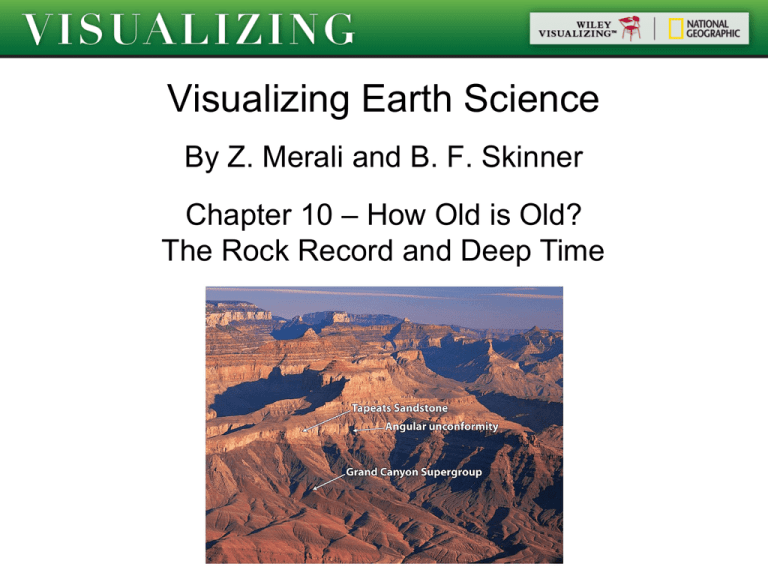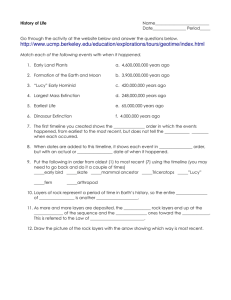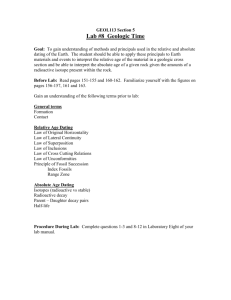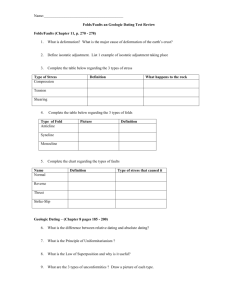4. Geologic Time and Earth History I
advertisement

Visualizing Earth Science By Z. Merali and B. F. Skinner Chapter 10 – How Old is Old? The Rock Record and Deep Time Chapter Overview • Relative Age • The Geologic Column • Numerical Age • The Age of Earth The Age Debate: A change of perspective • Catastrophism – Large scale geologic features formed in catastrophic events – The age of Earth measurable in human historical terms • Uniformitarianism – Past and present geological processes similar – Discarded catastrophic formation – Earth processes can be observed to understand past – Proposed the Earth was ancient much beyond the span of human history Relative Age • • Determination of sequence of geological events Use stratigraphy – Science of rock layers and strata forming processes – Law of original horizontality • Beds or strata laid in water are laid horizontal Relative Age • The principle of stratigraphic superposition - Undisturbed strata have younger layers above older ones Relative Age • Principles of stratigraphy – Principle of cross cutting relationships • Feature cutting through or disrupting a stratum – younger than the stratum Unconformities: Gaps in the record • Numerical age – Time elapsed since a feature formed • Unconformity – A chronological gap in sequence of rock layers Correlating Layers • Fossils – Signs of ancient living organisms • Usually consist of preserved hard parts – Paleontology • Study of fossils and ancient life – Fossils useful to correlate rock layers by age – Fossil succession – determine sequences in fossil records Correlating Layers Sequencing geologic time • The geologic column – Visual, suggestive representation of geologic time – Based on succession of rock strata – Major division -- Eon – Subdivisions – Eras, Periods and Epochs – Four eons • Current eon: Phanerozoic – visible life – Eras: Paleozoic, Mesozoic, Cenozoic • Past: Hadean, Archean, Protrozoic Sequencing geologic time Periods and Epochs Recent fossil record • Eras divided into periods – Based on fossil groups – Some period boundaries marked by extinctions • The Cambrian period – First of the Paleozoic era – Animals with hard shells – Period of “explosion” in biodiversity • • Precambrian – the whole of geologic time before the Cambrian period Periods last for multi-million years – Subdivided into epochs Numerical Age • Attempts made at estimating the age of Earth – Rate of sedimentation and thickness of strata • Too much variability in estimates – Ocean salt deposit rate (Halley) • Flaw in assumption – salt content not varying – Darwin’s estimate based on erosion processes • Rejected on the basis of thermodynamic cooling of Earth – Discovery of radioactivity reveals internal heating of Earth – Modern estimates (> 4.5 billion years) • Based on radiometric dating Numerical Age Radioactivity and Numerical Ages • Rocks contain internal clock – Radioactive matter decays at determinable rate – Development of sensitive instruments measuring • Rates of radioactive decay • Concentrations of elemental substances – Enabled measurement of numerical ages of rocks Radioactivity and Numerical Ages Radiometric dating Half life • Radioactive atoms decay into daughter products – Half life: time taken for half the atoms in sample to decay • Known half life and known initial concentrations of – Parent atoms – Daughter atoms • Provide accurate estimates of age when final concentration are measured Radiometric dating • Radiometric dating difficulties – Need to find • Rock samples with initially discoverable parent/daughter ratios • No contaminations to externally change parent daughter ratio after rock formation – Different dating techniques found for • Rocks, fossils and biological material – Based on estimated age and composition Radiometric dating Radiometric dating and the geologic column • Finding sedimentary strata with igneous inclusions – Provides an application of the radiometric dating technique to the geologic column • Fossil correlated layers can be dated – using the principles of stratigraphy – Numerical dates from radiometric dating Magnetic Polarity Dating • Earth’s magnetic field periodically reverses – During rock formation • Orientation of magnetized mineral grains locked in • Allows determination of magnetic field polarity – Field polarity measurements along with radiometric dating • Provide a timescale for more recent geologic time • Used to date history and succession of hominid fossils Modern estimates of the age of Earth • Earth has volcanic, geological and biogenic activity – Pristine rock from early Earth difficult to find – Oldest sedimentary rock mineral dated to 4.4 billion years • However sedimentation requires prior rock formation and erosion • Earth older than oldest rock – Moon rock samples and meteorites provide clues to age of planetary formation – Oldest meteorite 4.56 billion years old Chapter Summary • Relative Age - The Age Debate - Stratigraphy: Principles and Application - The Fossil Record • The Geologic Column - Sequencing Geologic Time: Eons, Eras, Epochs and Periods • Numerical Age - Numerical Age: The Age of Earth Problem - Radioactivity and Radiometric dating - Magnetic Polarity Dating • The Age of Earth - Modern estimates of the Age of Earth






